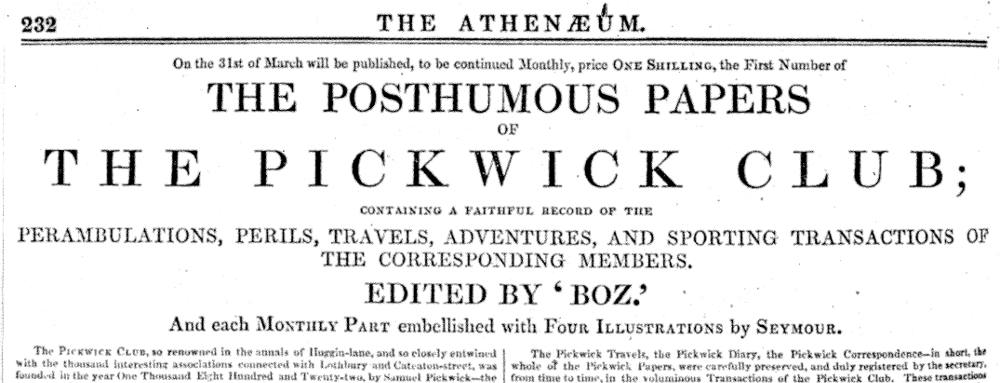The Monthly Wrapper
Robert Seymour
April 1836
steel engraving
11 cm high by 9.9 cm wide, vignetted
April 1836, Pickwick Papers by Charles Dickens
Scanned image and text by Philip V. Allingham.
[Victorian Web Home —> Visual Arts —> Illustration —> Robert Seymour —> Next]
The Monthly Wrapper
Robert Seymour
April 1836
steel engraving
11 cm high by 9.9 cm wide, vignetted
April 1836, Pickwick Papers by Charles Dickens
Scanned image and text by Philip V. Allingham.
[You may use this image without prior permission for any scholarly or educational purpose as long as you (1) credit the person who scanned the image and (2) link your document to this URL in a web document or cite the Victorian Web in a print one.]

The original advertisement in the Athenaeum announcing the forthcoming monthly serial. [Click on the image to enlarge it.]
The first plate, marking the inauguration of the Cockney sporting club, is set on 12 May 1827. Since the subject is a group of Londoners' setting up a "Nimrod Club," the initial plate seems completely consistent with Pickwick's fishing in the Thames. However, since such a scene never actually occurs in the novel, the monthly wrapper suggests a very poor state of dialogue and collaboration between the illustrator and the author at the very outset of the project. At least, Winkle's discharging a firearm at unseen prey occurs within the text, but the inept Cockney sportsman shoots a fellow-club member, Tracy Tupman, instead of the rook at which he is aiming. Phiz did not actually illustrate this misadventure until 1873 for the Household Edition volume of the novel.
Charles Dickens, despite his youth and desire to be a published author, had the nerve to object to William Hall's suggestion of the mere episodic adventures of a "Nimrod Club." His reticence is understandable since he had little knowledge of such sporting activities as his publishers had suggested. Moreover, Dickens probably felt that such a concept was already rather hackneyed — as a result of popular works by Seymour and Surtees between 1832 and 1834.
My views being deferred to, I thought of Mr. Pickwick, and wrote the first number; from the proof sheets of which, Mr. Seymour made his drawing of the Club, and his happy portrait of its founder: — the latter on Mr. Edward Chapman's description of the dress and bearing of a real personage whom I had often seen. I connected Mr. Pickwick with a club, because of the original suggestion, and I put in Mr.Winkle expressly for the use of Mr. Seymour. [Dickens, "Preface," The Household Edition, iv]
The serial wrapper somewhat spuriously presents Pickwick as an outdoorsman, and therefore more likely represents Seymour's notions about the direction in which the young writer should take the character. Seymour shows the fisherman in his town clothes (rather than garbed as a sportsman) asleep, although he has hooked a fish, on the downriver side of the Richmond Bridge in the background. By sheer coincidence, the same bridge appears in the background of Up the River in one of the last instalments of The Mystery of Edwin Drood.
Cohen, Jane Rabb. Charles Dickens and His Original Illustrators. Columbus: Ohio State U. P., 1980.
Davis, Paul. Charles Dickens A to Z: The Essential Reference to His Life and Work. New York: Facts On File and Checkmark Books, 1998.
Dickens, Charles. "The Mystery of Edwin Drood. Illustrated by Sir Luke Fildes. London: Chapman & Hall: 1880.
Dickens, Charles. "Pickwick Papers. Illustrated by Robert Seymour and Hablot Knight Browne ('Phiz'). London: Chapman & Hall: 1836-37.
Last modified 18 September 2019
